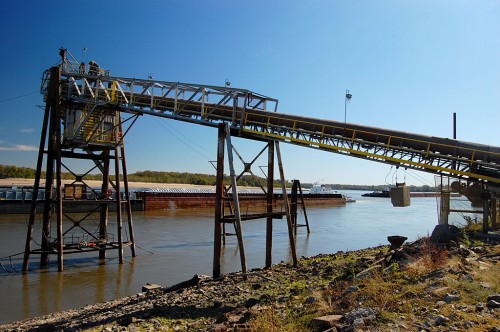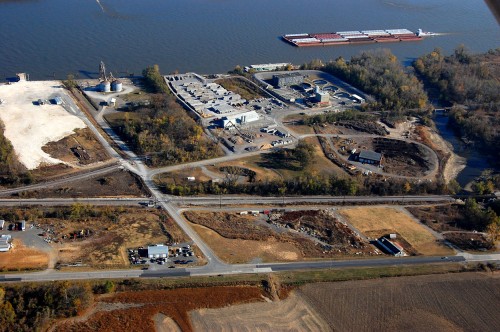 When I was stumbling around trying to find out how to get to the old M.E. Leming Lumber Company, I took a chance on going down LaCruz Street in what used to be Smelterville. I sort of didn’t see a sign that said don’t go here and popped out next to Consolidated Grain and Barge, now labeled CGB. I didn’t realize CGB was such a big deal until I checked out their webpage.
When I was stumbling around trying to find out how to get to the old M.E. Leming Lumber Company, I took a chance on going down LaCruz Street in what used to be Smelterville. I sort of didn’t see a sign that said don’t go here and popped out next to Consolidated Grain and Barge, now labeled CGB. I didn’t realize CGB was such a big deal until I checked out their webpage.
The barge in the photo is idling until a southbound tow gets past. The low water has had things a little tight of late. In order to be able to steer, a boat has to be able to go faster than the current, so the southbound traffic has the right of way.
Aerial of LaCruz Street area
 CGB is at the end of LaCruz Street, the street that runs from Sprigg, at the bottom, to the river. Look for the two storage bins to the right side of the light-colored lot. The facility just to the left of where the barge is passing is Cape’s Sewage Treatment Plant. Cape LaCroix Creek empties into the Mississippi at the right.
CGB is at the end of LaCruz Street, the street that runs from Sprigg, at the bottom, to the river. Look for the two storage bins to the right side of the light-colored lot. The facility just to the left of where the barge is passing is Cape’s Sewage Treatment Plant. Cape LaCroix Creek empties into the Mississippi at the right.
Photo gallery of CGB
Click on any photo to make it larger, then click on the left or right side of the image to move through the gallery.








I can not believe how Smelterville has changed, my Grandmother, Mattie Reed used to live just south of the Sprigg Street bridge (on the other side of Cape LaCroix Creek). They raised 9 children there. She and my grandfather came to Missouri from Southern Illinois by covered wagon when she was 14 years old and settled here, it was a 6 weeks journey.
My brother, myself and tons of cousins spent alot of time in that creek, jumping the little fall, catching crawdads, walking the tressle bridge and sometimes sneeking back to the river to watch the barges and boats go by. My father was a meat cutter at the packing house and would pick us up at grandmas after he was done.
Before the Reeds moved closer to Sprigg Street, they had a small house closer to the river, I don’t remember this, but my sister does. My grandfather used to have quite a few cattle and pigs and would take them over by boat to the island to graze. At night he was the watchman at the cement plant.
The house is no longer there which is sad for all of us. We spent alot of time there. Don’t know if the dairy farm is still across the street, but we went there quite often as well. We would sometimes get a quarter and be allowed to walk to Diediker’s to spend our fortune on a bag of bubblegum. We would go to the Baptist Church with my Grandmother and many times they would have a potluck with the best food I think I have ever had.
I would love any information that anyone might have in regards to where the records of the church might be. My sister and I are tracing “our roots”, and we would like to find these if they are available. If anyone knows of anything, please let me know, people would call her Miss Mattie.
Do the explosions still go off at the cement plant, I can remember that it would rattle the windows.
I must say the memories that I have of my childhood were some I will treasure for the rest of my life.
Is this the dairy you were referring to?
If you put Smelterville in the search box on the right-hand side of the page, several stories will pop up.
Hmmm….I saw this from aerial shots and I thought that this was a part of the cement works for loading cement into barges and the like. I often forget the real wealth in SEMO comes for the ground and the people who can get it to market. Multi national companies seem to find a good home in the midwestern USA and help all involved.
I will take a look at this when I get back into town next week!
Now if you can solve the mystery of the maybe minor league ball field downtown, then I will be happy…for now.
Yes, Ken that is the one! Thank you so much for posting these pictures, this really makes me want to return “home” for a visit. My sister and her family still live in Cape. My Grandmother place was directly acroos from the Dairy Farm, just north of Federal Materials Building. If you look close you might be able to see the remenants of her foundation. She paid her rent to the Federal Building as she was a tenent for life. I am told they used to There is a road on the south side of the Federal Building that goes back to the river, I remember a older man lived back there in a shack that was not fit for human or beast. he was very nice and I am sure he was just glad to have someone to talk to, so that we did, I am sure my younger brother remembers his name but at this time I don’t. We were told to never go back there, but of course we did. That road took us back to where their first homestead was. It was very near the mouth of the creek. Keep posting Ken, not many pictures from that era, so by doing so many can share the memories of the simple life. If you might know who or where I might contact to find the records for the church, please let me know. Again Thanks!
My father, Lou Hobbs had tons of stories about smelterville. He lived there and his stories were always filled with love for the people and his memories were all good. He also talked about may green school and how much he loved it. I loved seeing the pictures and reading the stories.. I would like to see more about this area. It need not be forgotten.
Nan
Ken,
The dairy farm you are speaking of was Hunzie (Not sure of the spelling) farm. My dad used to run a little service station just to the north of the Federal Materials building when I was a little girl. Just north of that was where the Reeds lived and behind them in a large house with a driveway that went around the house was where my Aunt Georgia and Uncle Sonny (Ralph) Wren lived with their family. We spent lots of time down in the creek catching crawfish and playing in the creek. Oh what wonderful memories I have from my childhood. Things were so much simpler then and everyone who lived in Smelterville knew everyone else and we all got along great. The color of our skin didn’t seem to matter a lot. I don’t think anyone ever locked their doors and the windows were always open in the summer. The worst part of living there was the smell of the packing house in the summer. Love your stories and the pictures, keep them coming.
Vonda